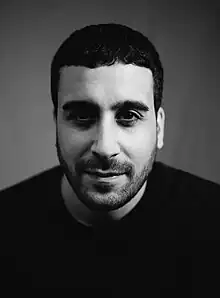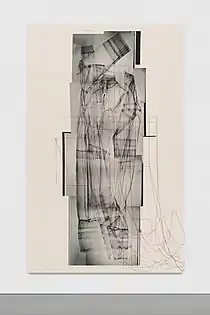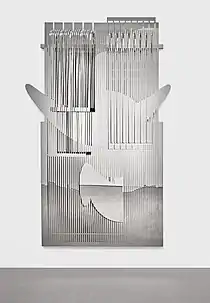Tarik Kiswanson | |
|---|---|
 | |
| Born | July 19, 1986 |
| Alma mater | |
| Occupation(s) | Sculptor, poet |
| Awards | Marcel Duchamp Prize (2023) |
| Website | tarikkiswanson |
Tarik Kiswanson, born 19 July 1986, Halmstad, is a Swedish visual artist.[1] He lives and works in Paris.
Early life and education
His parents, originally from Jerusalem, went into exile in Jordan and then Sweden in the early 1980s. When they arrived at the immigration office, their original name, al-Kiswani, was changed to Kiswanson. Tarik Kiswanson spent his childhood between Sweden and Jordan, where a large part of his family still lives.[2]
At the age of 17, he moved to London to study at Central Saint Martin’s School of Art. In 2010, he graduated with a Bachelor in Fine Arts and moved to Paris to continue his studies at the École Nationale Supérieure des Beaux Arts de Paris. He graduated with a D.N.S.A.P. with congratulations of the ENSBA jury of 2014.[3]
Work

His work encompasses sculpture, writing, performance, drawing, sound, and video works. Notions of rootlessness, regeneration, and renewal are central themes in his oeuvre. Always operating at the intersection of different cultural contexts, his various abstract works examine subjects related to memory, heritage, birth, loss and belonging. His oeuvre can be understood as a cosmology of related conceptual families, each exploring variations on themes like refraction, multiplication, disintegration, levitation, hybridity, and polyphony through their own distinct language.[4]
From Swedish to Arabic and from English to French, Tarik Kiswanson examines issues of displacement and intersititiality that relate specifically to the context of what is lost and what is gained in the second generation of migration.[5] The notions of uprooting, regeneration and renewal are recurrent themes in his work. His various works can be understood as a cosmology of related conceptual families, each exploring variations on subjects such as refraction, multiplication, disintegration, hybridity and polyphony, through their own specific language.[6] Édouard Glissant's "poetics of relationship" has greatly influenced the kinetic and reactive qualities of the artist's work.[7]
He is the winner of the 2023 Marcel Duchamp Prize.

Exhibitions
Solo exhibitions (selection)
- Afterwards, Salzburger Kunstverein, Salzbourg, Austria (2023)[8]
- Becoming, Bonniers Konsthall, Stockholm, Sweden (2023)[9]
- Nido, Museo Tamayo, Mexico City, Mexico (2023)[10]
- Anamnesis, M HKA - Musée d'Art contemporain d'Anvers (2022)
- Nest, Sfeir-Semler Gallery, Beyrouth, Lebanon (2022)
- Nest, Hallands Konstmuseum, Halmstad, Sweden (2022)
- Surging, carlier I gebauer, Berlin, Germany (2021)
- Mirrorbody, Carré d'Art, Nîmes, France (2020)[11]
- Dust, Centre Pompidou, Paris, France (2019)[12]
- Come of age, Fondation d'entreprise Ricard, Paris, France (2018)[13]
- Father Form, carlier | gebauer, Berlin, Germany (2017)[14]
- Ongoing Reflection, Collège des Bernardins, Paris, France (2016)[15] · [16]
Group exhibitions (selection)
- Marcel Duchamp Prize 2023, Centre Pompidou (2023)
- Form of the surrounding futures, Gothenburg International Biennial for Contemporary Art (2023)
- Elmgreen & Dragset: READ, Kunsthalle Praha, Praha, Czechia (2023)
- Manifesto of fragility, 16e Biennale d'art contemporain de Lyon, France (2022)
- Living In This Exquisite Corpse, Ambassade de France, Berne, Switzerland (2021)
- In The Open, The Common Guild, Glasgow, United-Kingdom (2021)
- Hi-storytelling, Sfeir-Semler Gallery, Hambourg, Germany (2021)
- Immortality, Ural biennial, Ekaterinburg, Rusia (2019)
- AS DEEP AS I COULD REMEMBER, AS FAR AS I COULD SEE, Performa 19 biennial, New York, United-States (2019)[17]
- Tainted Love Villa Arson, Nice, France (2019)[18]
- Today will happen, Biennale de Gwangju, South Korea (2018)[19]
Publications
- Exhibition catalogues
- Nest, Hallands Konstmuseum, Mousse Publishing, 2022
- Mirrorbody, Carré d’Art - Musée d’Art contemporain de Nîmes, DISTANZ, 2021
- Poetry books
- The Window, JBE Books, 2022
- AS DEEP AS I COULD REMEMBER, AS FAR AS I COULD SEE, JBE Books, 2018
Artist's book
- Becoming, Dilecta, 2023[20]
References
- ↑ "Tarik Kiswanson". Almine Rech Gallery. Retrieved 2021-03-22.
- ↑ "Tarik Kiswanson installe son « Nid » à la galerie Sfeir-Semler". L'Orient-Le Jour. 2022-04-05. Retrieved 2022-08-16.
- ↑ "Nos diplômés". BA (in French). Retrieved 2022-08-16.
- ↑ Brown, Kate (2021-05-04). "Artist Tarik Kiswanson on His Secret to Avoiding Creative Burnout, and the Inspiration for His Gallery Weekend Show in Berlin". Artnet News. Retrieved 2022-08-16.
- ↑ GG. "Tarik Kiswanson | Zérodeux / 02" (in French). Retrieved 2022-08-16.
- ↑ "BOMB Magazine | Tarik Kiswanson". BOMB Magazine. Retrieved 2022-08-16.
- ↑ "Thirteen and Thirty: Tarik Kiswanson — Mousse Magazine and Publishing". www.moussemagazine.it. 2021-07-05. Retrieved 2022-08-16.
- ↑ "Tarik Kiswanson. Afterwards". Salzburger Kunstverein. Retrieved 2023-07-13.
- ↑ Konsthall, Bonniers. "Tarik Kiswanson / Becoming". Bonniers Konsthall. Retrieved 2023-07-13.
- ↑ "Nido". www.museotamayo.org. Retrieved 2023-07-13.
- ↑ "TARIK KISWANSON - Expositions". Carré d’Art (in French). Retrieved 2021-03-22.
- ↑ "Move | Tarik Kiswanson". Centre Pompidou. Retrieved 2022-08-16.
- ↑ "Tarik Kiswanson — Come, come, come of age. — Fondation d'entreprise Ricard — Exposition". Slash Paris (in French). Retrieved 2021-03-22.
- ↑ "ART-PRESENTATION: Tarik Kiswanson-Flowers for my father". Retrieved 2021-03-23.
- ↑ "Tarik Kiswanson". Collège des Bernardins (in French). 2016-06-18. Retrieved 2021-03-22.
- ↑ "Jeune artiste : Tarik Kiswanson". Le Quotidien de l'Art (in French). Retrieved 2021-03-23.
- ↑ "Moving in the In-Between: Tarik Kiswanson |". Flash Art. 2019-10-09. Retrieved 2022-08-16.
- ↑ "La club culture dansée et pensée à la Villa Arson". Beaux Arts (in French). Retrieved 2021-03-23.
- ↑ "Tarik Kiswanson on the Forgotten Age of Childhood". ELEPHANT. 2018-09-10. Retrieved 2022-08-16.
- ↑ "Tarik Kiswanson. Becoming - Exposition Bonniers Konsthall". Éditions Dilecta (in French). Retrieved 2023-07-13.